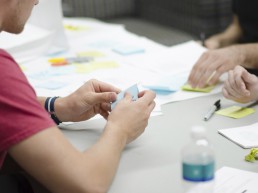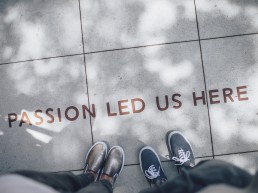Respecting the sum and its parts
You wouldn’t walk into an operating theatre, suggest to the surgeon that they might want to think about making that cut 4mm to the right, and offer to close the patient. Equally you wouldn’t bowl onto a building site laying bricks, ‘just because they look good there’ and all because you’ve seen and been in lots of houses. Human beings are generally good at respecting others’ expertise, so why is this so often not the case with graphic design? Do people not see this specialist area as an expertise?
Creativity benefits from like minds, collaborating and challenging one another in a constructive way. I certainly work better in this environment and believe that work is stronger and more robust as a consequence. No one, however, wants to be told how to do their job and disappointingly this happens more than I’d care to remember in the agency world. This tension between different parts of the internal team is usually due to poor communication (crazy right!) and can be incredibly damaging. If people aren’t working together towards a common goal or aren’t able to recognise and respect each other’s expertise, then the team isn’t working and the outputs will suffer.
This is why I believe it is so important to have the right team involved from the start, ensuring that we are all on the same page. Too often I have seen critical people missing from the initial stages of a project, citing that there is not enough budget to warrant so many people’s time. What undoubtably results is that more and more meetings are needed to unpick and solve problems further down the line, with more and more senior members included to try and get the work back on track. Ironically this results in spending more time and money than if all parties were invested in to begin with! Plus now with the added problem of having way too many cooks and too little time to complete the work with any aplomb.
All too often the root of the problem stems from not having agreed on, or written, a good enough brief. Now hang on a minute, before you groan with boredom and roll your eyes, just hear me out. If we as a united team; agency and client together, have defined and understood the problem, worked out a direction and plan to solve it together, then a lot of the friction later on can be avoided. By working together, embracing the restrictions and pressure points rather than fighting against them, we can ensure the output retains its strength and relevance and fulfils the initial need.
We have all spent time learning our respective craft, not because we wanted to be handed a list of instructions, but because we thrive on seeing good ideas come to life. We get a buzz out of using our expertise to create positive change and make a difference to people’s lives, and we all invest our precious time to achieve the outcomes we believe in. Quite simply, we need to have respect for, and see the value in, the expertise people bring to the table, and that only through collaboration and communication can truly great things happen. Once we believe this, we can finally build strong, bespoke, challenging, ‘fit for purpose’ teams that deliver truly exceptional work.
What’s wrong with progress?
We all know that clients increasingly need to do more with less. Marketing budgets are being cut continually, and expectations of ROI and proof of impact are higher than ever. In parallel, communications agencies are looking for ways to do more; with more focused, intelligent thinking and stronger creative. But this expertise comes at a price.
Agencies are left in a difficult position. With revenues and hourly rates heading south, margins are squeezed and cuts are inevitable. Agencies have always worked a certain way, and it isn’t a structure that can support the same commitment and expertise for a tighter budget. So when faced with the challenge of budget cuts, the solution is usually two-fold – put a less experienced (ie. cheaper) team on the business, and increase the number of hours to protect the final revenue number. This will keep the agency hitting its own targets in the short-term, but it isn’t a great solution for the agency or the client in the long-run, and the cracks will very soon appear. The client will feel there is a lack of commitment and the agency will feel the client doesn’t value their expertise.
This isn’t sustainable, let alone enjoyable. It’s a lose-lose situation that doesn’t produce good work or value for money. Instead, we need to recognise and embrace that times have changed. The challenge to do more with less isn’t going to go away, so rather than continuing to work with the same old model, we need to rethink the whole set-up. Agencies have always had layers of people, rigid structures that aren’t able to bend and flex to suit different needs, and margins factored in to cover big offices and staff downtime. It’s ok to challenge these things – in fact it needs to be done. Rather than trim around the edges, the answer is to think more creatively about how an agency works. And it’s simple – it needs trimmed back and agile structures, with bespoke teams tailored to specific needs rather than static teams sitting on the books waiting for the right work to come along. This meets the need to do more with less without compromising on the good bits. So rather than cutting the experience, expertise and motivation of the team, you cut everything else instead. The bits that will make absolutely no difference to how great an idea is, how effective a campaign can be, or the expertise an agency can bring.
Change is nothing to be afraid of – quite the opposite – it’s progress.

